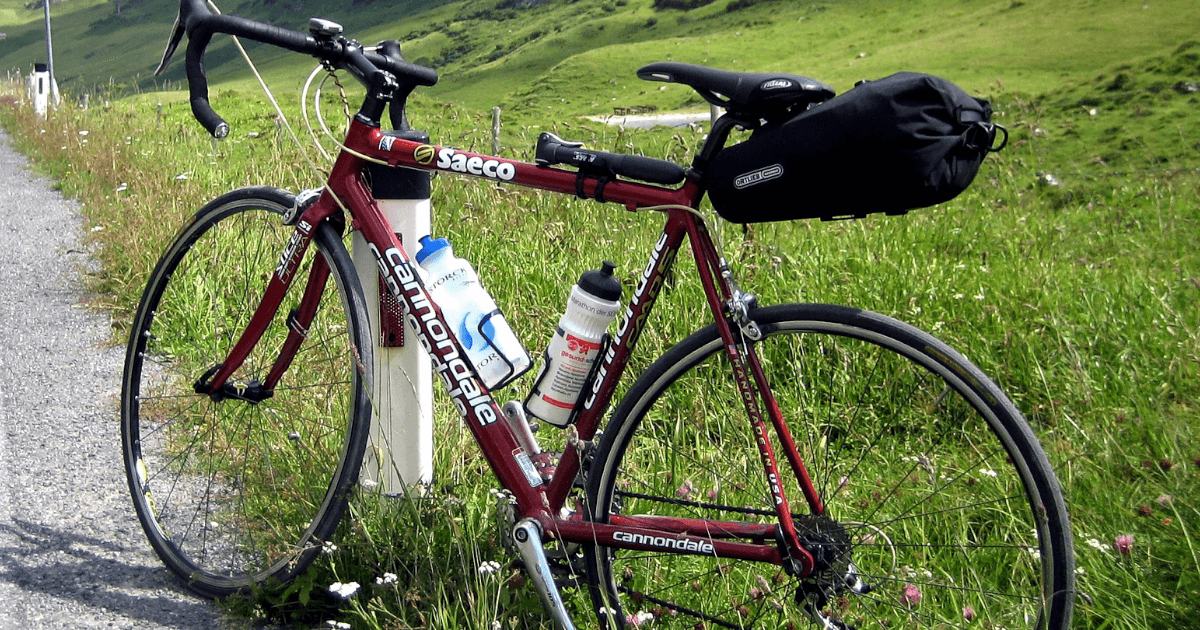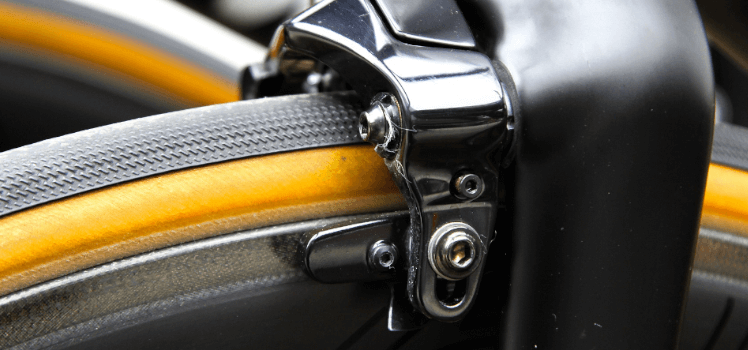Overview and Specifications of WheelTop's Affordable Electronic Groupset "EDS"
This article summarizes the features and specifications of the budget-friendly electronic groupset "EDS" newly released by the Chinese manufacturer WheelTop.
Posted at: Aug 27, 2021
Gravel roads are becoming more and more popular as they can be enjoyed both on paved roads and slightly off-road. In this article, we have compiled a list of points to check when converting your current road bike to gravel.

Table of contents
Sponsored Link
There is no clear rule that a road bike should be called gravel road if it has gravel parts, but the first thing to consider is to widen the tires. Today’s road bikes are mostly equipped with 25C tires, while gravel bikes are equipped with 35C or 38C tires.
Changing tires is the same as changing tires on a normal road bike, but the problem is the tire clearance. Tire clearance refers to the distance between the tire and the seat stay (frame), and between the tire and the fork.

“However, the “00C” on the tire size indicates the distance from the wheel rim to the outer circumference of the tire, so replacing a 25C tire with a 35C tire will usually increase the height of the tire by 1cm.
If the frame has a wide tire clearance, there is no problem, but since most road bikes have a tire clearance of about 28C, the tire will interfere with the seatstays and fork, or with the brakes if the bike is equipped with rim brakes. This is probably the reason why many gravel roads have disc brakes.
When widening the tires on your road bike, measure the tire clearance beforehand. Measure the distance between the current tire and the brake, and consider -3 to 5mm as the maximum tire size for safety.
Changing Bicycle Tire Size and Thickness: 3 Key Points
Tire customization is a fun way to change the riding experience for a cost of about $100. When replacing tires, there are three points to keep in mind when changing the size and thickness of your bicycle tires.
This is not a problem if you are commuting, but if you are cycling or touring on gravel roads, you should consider the possibility of mud or other debris clogging up the chain and causing it to fall off.
Gravel components are often equipped with anti-dirt measures (to prevent the chain from getting stuck and mud from getting into the chain), but road components are designed for riding on paved roads and are not very resistant to dirt.
However, road components are designed for riding on paved roads, and are not very resistant to dirt. Even if you are not going to ride on serious mountain roads like MTB, if you are going to gravel ride on unpaved mountain roads, you should replace the rear derailleur and chainring with dirt-compatible components, as they tend to chew gravel and mud and cause the chain to fall off.
Replacing the front chainring with a narrow wide chainring will dramatically improve chain drop.
Preventing Bicycle Chain from Falling Off - Tips and Tricks
A common problem with road bikes, hybrid bikes, and other bicycles with a front shifting function is the chain falling off. Here are some tips on how to prevent the chain from falling off.
If you are going to partially replace your bike with a gravel component, you should pay attention to the compatibility of the parts.
In Shimano’s case, the gravel component is the GRX, but the compatible components for the GRX are determined by Shimano. It is not impossible to work with components outside of Shimano’s regulations, but considering the trouble of making minor adjustments, it is safer to match the official compatibility of the manufacturer.
Shimano Road Components Compatible with GRX Gravel
Shimano's GRX series of gravel components can be used in combination with other road bike components, including tips on how to mix and match.
Unlike paved roads, where troubles are not that common or solutions to problems are affordable, the roads that gravel roads are designed to be ridden on are often in places where there are few stores and people.
In such places, you have to deal with punctures by yourself, and if you are riding on mountain roads, sudden weather changes are a daily occurrence in the mountains. Also, unlike in urban areas, if you get lost, you may end up wandering off in a crazy direction, so a smartphone navigation system is a must.
When riding in areas where gravel roads are active, it is a good idea to carry the following items.
It is a good idea to have a mobile battery/cable with you so that you can call an ambulance in case of emergency.
If you are going to do camping touring or long ride cycling on a gravel road, it will be more comfortable to store your luggage in the frame.
Road bikes have fewer “dowel holes” for storage than gravel roads, so you can use larger frame bags and saddle bags to increase the load capacity for a more comfortable ride.
When camping, luggage should be at least 50L, so if you are camping touring, augment your load capacity to about 50L by combining bags that can be attached to your bike.
If you are not camping touring, you can adjust the number of bags by reducing the number of bags.
Sponsored Link
Road Bike vs Gravel Bike: Key Factors to Consider
Gravel bikes have been rapidly gaining in popularity over the past few years. But what is the difference between a standard road bike and a gravel bike? We have compiled a list of tips on how to recognize a gravel bike and what to look for when choosing one.
Gravel Bike Group Sets from Major Manufacturers
Gravel bikes have been rapidly gaining in popularity over the past few years. While the number of complete bikes has been increasing, component makers have also started to offer specialized components for gravel bikes.
Shimano's GRX Gravel Bike Components and Features
The following is a summary of Shimano's GRX lineup of components for gravel bikes, its features, and the advantages and disadvantages of choosing GRX.
SENSAH's components for MTB and gravel
This is a summary of Chinese bicycle parts manufacturer SENSAH's components for MTB and gravel. It also includes the equivalent Shimano componentry grade and compatibility with Shimano parts.
Converting Your Road Bike to Gravel: Key Points to Consider
Gravel roads are becoming more and more popular as they can be enjoyed both on paved roads and slightly off-road. In this article, we have compiled a list of points to check when converting your current road bike to gravel.
Changing Bicycle Tire Size and Thickness: 3 Key Points
Tire customization is a fun way to change the riding experience for a cost of about $100. When replacing tires, there are three points to keep in mind when changing the size and thickness of your bicycle tires.
Shimano Road Components Compatible with GRX Gravel
Shimano's GRX series of gravel components can be used in combination with other road bike components, including tips on how to mix and match.
Shimano's GRX Gravel Bike Components and Features
The following is a summary of Shimano's GRX lineup of components for gravel bikes, its features, and the advantages and disadvantages of choosing GRX.
Shimano Road Components Compatible with GRX Gravel
Shimano's GRX series of gravel components can be used in combination with other road bike components, including tips on how to mix and match.
Converting Your Road Bike to Gravel: Key Points to Consider
Gravel roads are becoming more and more popular as they can be enjoyed both on paved roads and slightly off-road. In this article, we have compiled a list of points to check when converting your current road bike to gravel.
Gravel Bike Group Sets from Major Manufacturers
Gravel bikes have been rapidly gaining in popularity over the past few years. While the number of complete bikes has been increasing, component makers have also started to offer specialized components for gravel bikes.
Advantages and disadvantages of front single
The "front single" without front shifting is being increasingly adopted in MTB and gravel road bikes. This section summarizes the advantages and disadvantages of the front single.
Overview and Specifications of WheelTop's Affordable Electronic Groupset "EDS"
This article summarizes the features and specifications of the budget-friendly electronic groupset "EDS" newly released by the Chinese manufacturer WheelTop.
What Is Shimano Shadow RD? Features and Benefits
What is Shimano’s Shadow RD used in their latest rear derailleurs? This article explains its features and the benefits of choosing Shadow RD.
[MTB / Hybrid Bike] Hydraulic Brake Manufacturers for Flat Bars
An overview of manufacturers that produce hydraulic brakes for flat-bar MTB and hybrid bikes, along with their key features. Also includes tips on how to choose the right flat-bar hydraulic brake brand.
Shimano Chain Compatibility for Road, MTB, and Hybrid Bikes
An overview of Shimano chain compatibility across road bikes, mountain bikes, and hybrid bikes. Includes guidance on how to choose the right chain for your drivetrain.
Shimano ESSA Lineup and Compatibility with Existing 8-Speed Parts
An overview of Shimano's newly released 8-speed component group "ESSA" and its compatibility with existing 8-speed parts.
SRAM Cassette Compatibility Guide
Compatibility guide for SRAM cassettes used in road and MTB bikes. Find matching drivetrains and wheels easily.
Compatibility Guide for SRAM MTB Components
A detailed explanation of compatibility between SRAM MTB components. This guide outlines which parts can be used together and which combinations are not compatible.
Road and MTB Sprockets Compatibility Overview
A guide to the compatibility between road and MTB sprockets, explaining whether they can be used together with different components.
Types of Shimano Di2 Tools and Their Compatibility
A guide to the essential Shimano Di2-specific tools, especially the "plug tools" used for connecting components, and their compatibility with various Di2 parts.
Shimano CUES Cassette Compatibility Guide
A detailed guide to the compatibility of Shimano CUES series cassettes. Includes an overview of compatible rear derailleurs, chains, and wheels.
Shimano Hydraulic Brake Hose and Connector Standards Guide
An explanation of the differences between Shimano’s hydraulic brake hoses BH90 and BH59, the types of connecting bolts, and how to choose the right hose for your brake system—including key points to watch out for.
[By Manufacturer] Types, Features, Pros and Cons of Hydraulic Brake Oils
This article explains the types of hydraulic oils used in bicycle hydraulic brakes, their characteristics, and the brake oil types used by each manufacturer.
Types and Compatibility of Shimano Di2 Batteries
The Di2 battery is the core of the Shimano Di2 system, influencing the overall system layout. This article explains the different types and their compatibility.
Shimano Di2 Wire Types and Compatibility
Overview of Shimano Di2 electric wire types and their compatibility with Di2 components.
How to Identify Shimano Di2 Generations
Explains the generational differences in Shimano Di2 components and their compatibility. Includes a list of component series and their corresponding generations.
In-Depth Guide to Shimano 12-Speed Cassette Compatibility
A detailed explanation of the key compatibility factors when using Shimano's 12-speed cassettes—specifically the required wheel (freehub) and drivetrain, which differ significantly from previous 11-speed systems.
Perfect Guide to Shimano 11-Speed Cassette Compatibility
A detailed explanation of two key compatibility factors when using Shimano 11-speed cassettes: the required wheel (freehub) and drivetrain.
Perfect Guide to Shimano 10-Speed Cassette Compatibility
A detailed explanation of two key compatibility factors when using Shimano 10-speed cassettes: the required wheel (freehub) and drivetrain.
In-Depth Guide to Shimano 9-Speed Cassette Compatibility
A comprehensive explanation of two key compatibility factors when using Shimano 9-speed cassettes: the required wheel (freehub) and drivetrain.
What Is a BOOST Crank? Differences from Standard MTB Cranks and How to Choose
This article explains what a BOOST crank is, how it differs from conventional MTB cranks, and provides guidance on selection across different manufacturers.